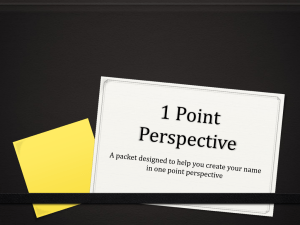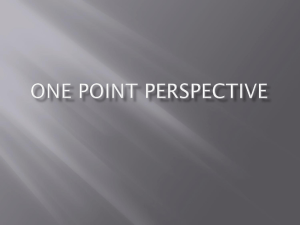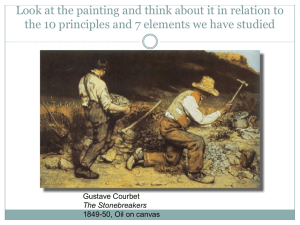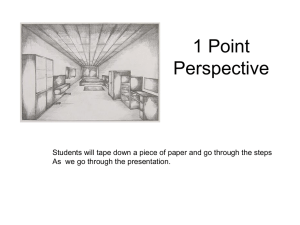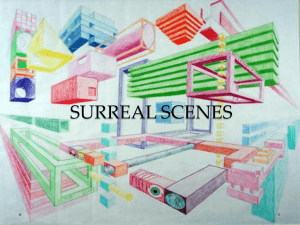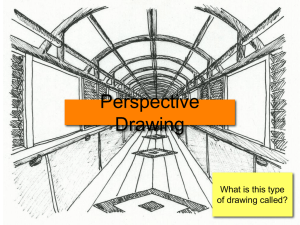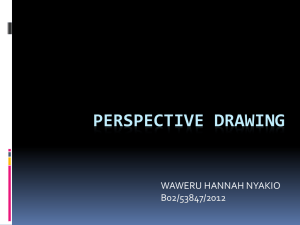File - Ms. Kays Art World
advertisement
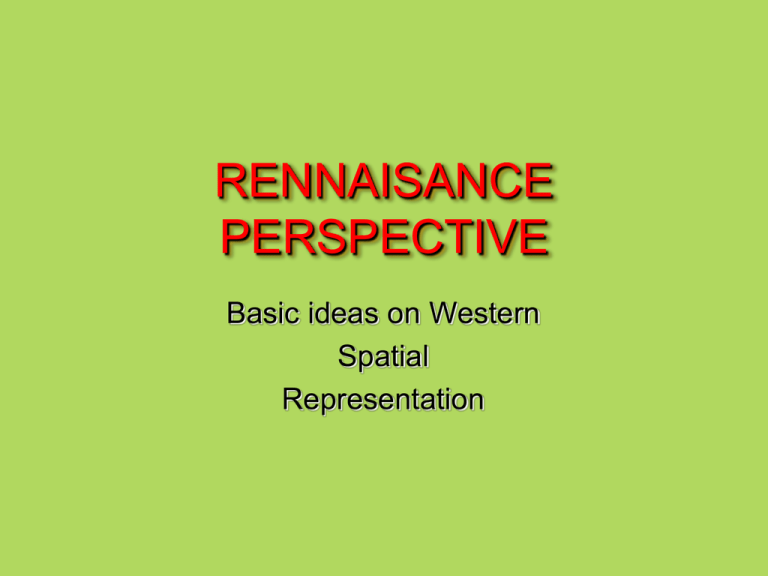
RENNAISANCE PERSPECTIVE Basic ideas on Western Spatial Representation The perspective system Representing “real space” in a 2D surface One point perspective, Central Perspective or Linear perspective The perspective system Representing real space in a 2D surface One point perspective, Central or Linear perspective. The horizon line in perspective drawing is a horizontal line across the picture. It is always at eye level - its placement determines where we seem to be looking from (a high place, or from close to the ground). The actual horizon might not be visible, but you need to draw a 'virtual' horizon to construct a picture in perspective. Objects are perceived smaller as they get close to that line. That line represents the “visible infinite”: the visible end of earth or water. Perspective Vanishing point on the horizon line * * The horizon line defines our position as a viewer: it is always placed at eye level. When we look at a photograph we assume the position of the photographer Perspective The Vanishing point VP vanishing point It is placed on the horizon line. All the vanishing lines converge to that point. Eyes of the viewer at this level In Linear Perspective drawing, The lines that go from the viewer to the infinite (the ones that would represent 3D space) are drawn along receding along towards the vanishing point. Feet of the viewer at this level Perspective Vanishing point Basic attempt to perspective with incorrect sizing in the figures Perspective Vanishing point Perspective Vanishing point Playing with Perspective Those are photos that are defying the representation of Space by using strong perceptual patterns, like Proximity that produce a simple and appealing explanation of what is seen. Perspective The Vanishing point in 1 point perspective Because the perspective system is based on optics and lenses (how we humans see), Photographic images match Perspective, since they capture reality from the point of view of a lens. Perspective Vanishing point VP vanishing point On the horizon line Where all the vanishing lines converge. Horizon line Vanishing lines. Frame of film “Lequai” from director Jean Cocteau . Perspective Vanishing point VP vanishing point On the horizon line Where all the vanishing lines converge. Vanishing lines. Frame of film “Lequai” from director Jean Cocteau . Perspective 1 point or Linear Perspective Foreshortening The distortion that perspective causes over objects seen from a particular viewpoint. It is more obvious as we get closer to the horizon. Perspective Vanishing point Non Congruent Perspective rendering Perspective Vanishing point Non Congruent Perspective rendering Perspective is founded on Optics. The curved lens in our eyes, or the lens in the camera Interprets objects in a distorted but organized way. Very low point of view, camera pointed high Perspective Drawing circles according to Central Perspective Perspective Vanishing point Highly deformed arches Highly deformed Geometrical figure Highly deformed circles Perspective Drawing geometrical shapes according to Central Perspective Perspective Parallel objects in a space seen with a one point perspective. (typical urban landscape seen through Central Perspective) Perspective Parallel objects in a space seen with a one point perspective. (typical urban landscape) Masaccio, and Masolino . Brancacci Chapel of Santa Maria della Carmine in Florence, 1426-28 Perspective Parallel objects in a space seen with a one point perspective. (typical urban landscape) Masaccio, and Masolino . Brancacci Chapel of Santa Maria della Carmine in Florence, 1426-28 Perspective Parallel objects seen from a central point of view inside a cube. (typical interior situation) Perspective Parallel objects seen from a central point of view inside a cube. (frontal view) Perspective Parallel objects seen from a central point of view inside a cube. (frontal view) Perspective Parallel objects seen from a central point of view inside a cube. (typical interior situation,) Early Rennaisance Sandro Boticelli (1445-1510) “The Cestello Annunciation” 56 x 150 cm (61,3 x 59,0 inches Perspective Parallel objects seen from a central point of view Early Rennaisance, Sandro Boticelli (1445-1510) “Nastagio-degli-onesti”1483 The marriage of the virgin, 1504. “Lo sposalizio della vergine” Pinacoteca Brera, Milano. Raffaello Perspective Central point of view inside a cube. Lorenzo Ghilberti, Architect 1378-1455 Porta Baptisterio Fiorenze. Bass Relief Perspective Central point of view inside a cube. Lorenzo Ghilberti, Architect 1378-1455 Porta Baptisterio Fiorenze. Bass Relief Horizon line Lorenzo Ghilberti, Architect 1378-1455 Porta Baptisterio Fiorenze. Bass Relief Paolo Ucello. St. George and the Dragon, 1456. National Gallery, London. Perspective Parallel objects seen from a central point of view inside a cube.example Paolo Ucello. St. George and the Dragon, 1456. National Gallery, London Attempt to apply perspective to nature in the XV century. Perspective Parallel objects seen from a central point of view inside a cube.example The perspective system Representing “real space” in a 2D surface Vanishing point 1 Vanishing point 2 Object is in oblique position to the viewer Parallel lines merge on the same side point Two point perspective, or Oblique perspective Perspective First vanishing point Parallel objects seen with a 2 point view inside a cube. The lines going towards the vanishing points are perpendicular to each other. As you move away from the central area objects appear somehow deformed (perspective aberration). Second vanishing point Horizon line Perspective 2 point view Horizon line Perspective A cube seen with a 2 point view Outside a central sphere, marked by the viewers point, objects get very deformed if placed to the bottom of the page or towards the bottom and the sides. Perspective A cube seen with a 2 point view Outside a central sphere, marked by the viewers point, objects get very deformed if placed to the bottom of the page or towards the bottom and the sides. Notice that to truly represent a cube, both vanishing points need to form a 90 degree angle with center on the vertical representing the viewers stand point. That vertical is defined by the closest angle of the cube. Because this cube is placed very close to the bottom of the page it shows a lot of deformation, specially in the lower part. Perspective A cube seen with a 2 point view Outside a central sphere, marked by the viewers point, objects get very deformed if placed to the bottom of the page or towards the bottom and the sides. Both vanishing points are still forming a 90 degree angle with center on the vertical representing the viewers stand point. That 90 degree can be placed upper or lower on that vertical. It is usually calculated by making sure that the distance from the horizon to the center of the angle (up of the page) is the same than the distance from the bottom of the drawing to the horizon. The higher the center of that imaginary angle, the further apart the vanishing points will be and the less deformation we will get. As a general rule the vanishing points (at lest one of them or both) should be outside the border of you paper. Perspective A cube seen with a 2 point view The cube to the right has less deformation because of being placed towards the center of that imaginary sphere Perspective A cube seen with a 2 point view With more measurements we could calculate how a real object (with defined measurements) would look in our defined space. VP 2 Perspective A cube seen with a 2 point view Objects placed in a different angle to the viewer will have different vanishing points. Because a city is built in an orthogonal plan, The whole view can be built with only 2 vanishing points. Perspective 2 point perspective (typical interior situation Side view) Rene Magritte French Surrealist artist. 1898-1967 Perspective 2 point perspective Tetsuya Ishida Japanese contemporary artist, 1973-2005 Perspective 2 point perspective Tetsuya Ishida Japanese contemporary artist, 1973-2005 Perspective Spiral staircase Perspective Revolving structure Rennaisance passion for Perspective and Geometry. Paolo Ucello, “Drawing of a chalice”, 1430 Pen and ink Galleria degli Uffizi, Florence Vasari called perspective: “A tours de force of illusion “ Shading an object Lit from a single source of light (point of light) Shading an object with multiple planes Lit from a single point (source) Shading an object Calculating the projected shadows of an object According to a light source. Reflective objects Calculating the reflection projected on a cylindrical surface. Reflective objects 3 Point perspective. Reflective objects 3 Point perspective. Reflective objects 3 Point perspective 3 and 4 Point perspective. 4 Point perspective Ascending and Descending, Lithograph, 1960 M.C. Escher Hand with reflecting sphere, Lithograph, 1935 M.C. Escher

